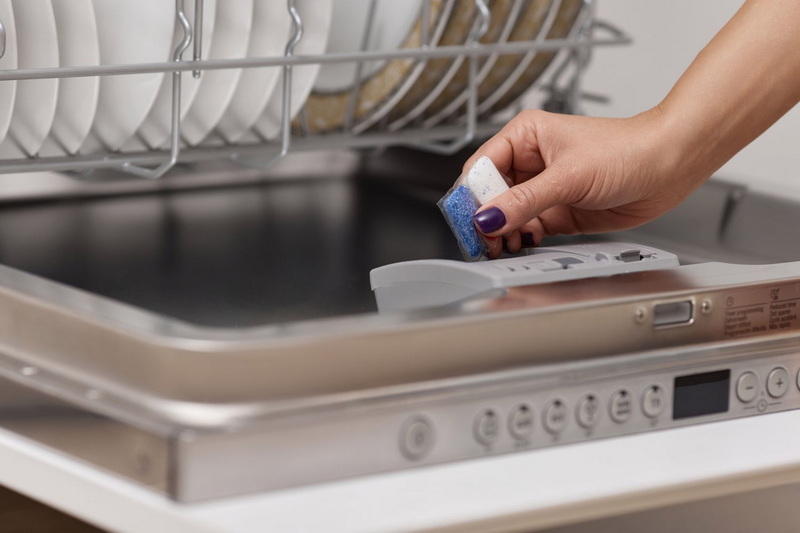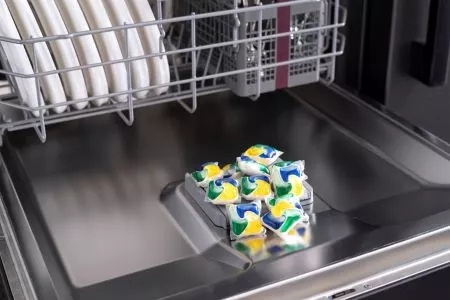Dongguan UFine Daily Chemical Co.,Ltd.
- All
- Product Name
- Product Keyword
- Product Model
- Product Summary
- Product Description
- Multi Field Search
Views: 222 Author: Tomorrow Publish Time: 11-01-2025 Origin: Site











Content Menu
● How pod formulations work in practice
● Plausible mechanisms of harm
● Population risk considerations
● Storage, handling, and safety best practices
● Environmental and occupational considerations
● Product design and consumer education
● Common exposure scenarios and responses
● What consumers should know about labeling
● Impact on public health and policy
● Caring for vulnerable populations
● Safe disposal and spill management
● Technology and future innovations
● Comparing dishwasher pods with alternative detergents
● FAQ
>> 1. Are dishwasher pods more toxic than other forms of detergent?
>> 2. What should I do if a child swallows a dishwasher pod?
>> 3. Can dishwasher pods cause skin irritation?
>> 4. How should dishwasher pods be stored to prevent accidents?
>> 5. Do dishwasher pods harm the environment?
Dishwasher pods have become a convenient and popular cleaning option for households around the world. They combine potent cleaning agents, surfactants, enzymes, and additives into a single, pre-measured unit designed to simplify dishwashing. However, their compact packaging, bright colors, and attractive scents can attract children and pets, raising concerns about safety and potential toxicity. This article examines the toxicity of dishwasher pods, how they work, common exposure scenarios, and practical safety measures to reduce risk. It also provides a structured FAQ section with evidence-based guidance for households, caregivers, and professionals who deal with cleaning products.

Dishwasher pods, also known as dishwasher detergent pods or packs, are small, water-soluble capsules that contain a mixture of cleaning agents. These typically include:
- Surfactants that loosen grease and soil from dishes
- Builders or water-softening agents to enhance cleaning efficiency
- Enzymes to break down food residues
- Preservatives and stabilizers to maintain pod integrity
- Colorants and fragrances to improve consumer experience
The pod's outer film dissolves in water during the wash cycle, releasing the contents to interact with dishes, water hardness, and rinse processes.
In a typical automatic dishwasher, the pod is placed in the dispenser or directly in the washing chamber. When the cycle starts and water enters the machine, the pod dissolves, releasing cleaning agents that:
- Break down fats, proteins, and starches
- Suspend soils so they can be rinsed away
- Protect cookware surfaces from mineral deposits
- Help prevent filming or residue on glassware
Pod performance depends on water temperature, mechanical action, and the dishwasher's design. Proper dosing is key: using the recommended amount reduces the risk of residue or over-sudsing and helps protect the machine and pipes.
Toxicity depends on the specific formulation and exposure route. The primary concerns with dishwasher pods are ingestion and, less commonly, eye or skin exposure. General points include:
- Ingestion: Swallowing dishwasher pods can cause oropharyngeal irritation, vomiting, abdominal pain, and, in severe cases, aspiration into the lungs, which can be dangerous. The shock of ingestion can also trigger metabolic disturbances or electrolyte imbalances depending on the ingredients.
- Eye exposure: Contact with eyes may cause irritation, redness, tearing, or more significant corneal irritation if not promptly flushed.
- Skin exposure: Short-term skin contact can lead to irritation or dermatitis in sensitive individuals, though most people tolerate brief exposures without systemic effects. Prolonged contact may increase irritation risk. Some formulations include allergens or fragrance compounds that can trigger reactions in sensitive people.
- Systemic toxicity: Most dishwasher pod ingredients are not highly toxic at the amounts released during a standard exposure, but concentrated exposures can be harmful. The risk is higher for children and pets who may be attracted to the bright colors and shapes.
- Chemical irritation: Surfactants and detergents disrupt lipid membranes and mucous linings, causing irritation of the mouth, throat, eyes, and skin.
- Aspiration risk: Swallowed material can be aspirated into the lungs during vomiting, leading to chemical pneumonitis.
- Gastrointestinal effects: Nausea, vomiting, and abdominal pain arise from irritant effects on GI mucosa.
- Allergic or sensitization responses: Some individuals may experience contact dermatitis from certain fragrance components or preservatives.
- Colorant-related concerns: Some colorants may cause transient skin or mucosal irritation in sensitive individuals; though generally regarded as inert in typical exposure scenarios.
- Children under five: The primary high-risk group because curiosity and oral exploration can lead to ingestion or exposure during play.
- Pets: Dogs and cats may ingest pods, leading to nausea, drooling, vomiting, or more severe symptoms.
- Individuals with cognitive or motor impairments: May have difficulty keeping pods out of reach or may mishandle containers.
- People with skin conditions or respiratory sensitivities: May experience amplified irritation from exposure to fragrances or surfactants.
To minimize risk, adopt a safety-first approach in homes, childcare settings, and facilities:
- Keep pods in their original labeled containers, tightly closed, and out of reach of children and pets.
- Store away from foods and beverages to avoid confusion or contamination.
- Use child-resistant packaging and always supervise children during household cleaning activities.
- Do not place pods in easy-to-access locations like countertops, drawers, or shelves within reach of young children.
- Do not transfer pods to unmarked containers (such as cups, bowls, or jars) that might tempt ingestion.
- Read and follow label instructions, including the recommended dosage and usage warnings.
- If a pod is ingested or there is eye or skin exposure, seek medical advice promptly. Do not induce vomiting unless advised by poison control or a medical professional.
- In case of spillage or exposure, rinse skin or eyes with clean water for several minutes and remove contaminated clothing.
- Use age-appropriate storage solutions in households with toddlers, including locked cabinets or high placement.

- Environmental impact: Surfactants and phosphates (where used) can affect aquatic ecosystems if wastewater treatment is overwhelmed. Modern formulations often limit phosphates and use more biodegradable ingredients. Biodegradability varies by formulation; managers should consider lifecycle analyses when selecting products for institutional use.
- Occupational exposure: Cleaners and maintenance staff handling pods should use gloves and ensure proper ventilation to reduce exposure to irritants. Training on safe storage and spill response is beneficial in workplaces.
- Waste management: Containers and residual packaging should be recycled where possible. Do not puncture pods to extract contents; disposal should follow local guidelines.
- Clear labeling: Labels should clearly indicate hazards, first-aid measures, and safe storage requirements.
- Child-resistant features: Packaging must deter access by small children.
- Transparent ingredient disclosure: While some manufacturers protect trade secrets, providing safer, more transparent ingredient information can help healthcare professionals respond to exposures more effectively.
- Public education: Community outreach about the dangers of pod exposure, particularly among caregivers, can reduce accidental ingestions.
- User-friendly packaging: Consider blister-pack or multi-layer films that still maintain safety while improving visibility of warnings.
- Accidental ingestion by a child: Immediately call your local poison control center or seek medical help. Do not induce vomiting unless advised. Do not give fluids if there is concern about airway compromise.
- Splash into eyes: Rinse eyes with clean, lukewarm water for 15 minutes while holding the eyelids open. Seek medical evaluation if irritation persists.
- Skin contact: Wash with soap and water. Remove contaminated clothing. If irritation develops or persists, consult a healthcare professional.
- Ingestion by pets: Contact a veterinarian immediately or call poison control for guidance. Do not rely on home remedies; professional advice is essential.
- Inhalation exposure: If fumes are present or the product is smelling strongly, move to fresh air and seek medical advice if symptoms persist.
- Look for explicit warnings about ingestion, eye contact, and skin contact.
- Check for age-appropriate storage notices and child-safety features.
- Verify disposal instructions and environmental impact statements, if any.
- Be aware of the product's ingredients and their potential irritant or sensitizing properties.
- Look for dosage guidance and whether the product is suitable for septic systems.
- Data collection on exposure incidents helps shape preventive strategies and regulatory standards.
- Policies encouraging safer packaging and clearer labeling can reduce accidental exposures.
- Ongoing evaluation of ingredient safety, along with improvements in eco-friendliness and biodegradability, supports both consumer protection and environmental stewardship.
- Public health messaging should emphasize safe storage and immediate steps after exposure to minimize harm.
- In households with small children or elderly individuals, additional precautions include using locked storage cabinets and ensuring cleaning products are not accessible.
- Educational materials for parents and caregivers should emphasize the importance of supervising children during household chores and teaching safe disposal practices.
- For individuals with limited mobility or cognitive challenges, consider automated dosing systems for dishwasher products or secure, lockable storage within reach.
- Follow local guidelines for disposing of cleaning products and containers.
- For small spills, use absorbent materials to contain the spill and place contaminated items in a sealable bag before disposal.
- Never pour cleaning pod remnants down the drain in large quantities without ensuring the line can handle it, and avoid mixing with other cleaning products to prevent hazardous reactions.
- If there is a significant spill in a commercial setting, evacuate the area and follow your institution's hazardous-material protocol.
- Child-resistant packaging innovations aim to make access more difficult without impeding adult use.
- Formulation improvements may reduce irritation potential while maintaining cleaning performance.
- Smart labeling techniques, such as QR codes linking to safety information, can provide quick access to handling instructions.
- Research into non-toxic and biodegradable surfactants continues to balance cleaning efficacy with environmental considerations.
- Auto-dispensing systems in professional kitchens may help standardize dosing and reduce human error.
| Detergent type | Key benefits | Potential drawbacks | Safety considerations |
|---|---|---|---|
| Dishwasher pods | Easy to use, pre-measured doses, consistent performance | Ingestion risk for children, packaging attractive to kids | Store securely, keep out of reach, follow label directions |
| Liquid dishwasher detergents | Often lower cost per load, flexible dosing | Dosing errors possible, spills and leaks | Store in stable containers, clean up leaks promptly |
| Powder detergents | Long shelf life, strong cleaning power | Dust exposure, risk of overuse | Use scoops, seal containers, avoid direct contact with skin |
| Gel-based detergents | Reduced splashing, controlled dosing | Similar ingestion risks if accessible | Secure storage, supervise children during use |
Dishwasher pods provide convenient, effective cleaning for modern kitchens, but they pose toxicity and safety concerns primarily due to ingestion risks in children and pets, as well as potential eye or skin exposure. By understanding how pods work, adopting strict storage practices, and educating household members about safe use, households can minimize hazards while maintaining cleaning performance. Continuous improvements in packaging, labeling, and formulation will further enhance safety without compromising effectiveness. Stakeholders across manufacturers, retailers, and consumers should collaborate to promote safer designs, better education, and more transparent ingredient information to reduce accidental exposures.

Dishwasher pods concentrate cleaning agents in a single packet, which can lead to a higher risk if ingested in small quantities by children or pets. Proper storage and handling reduce these risks.
Immediately seek medical advice or contact poison control. Do not induce vomiting unless instructed by a healthcare professional.
Yes, brief skin contact can cause irritation for some individuals. Wash the area with soap and water and remove contaminated clothing if irritation occurs.
Store in their original, tightly closed container, out of reach and sight of children and pets, preferably in a locked cabinet.
Some formulations can impact aquatic environments if released in large amounts. Choose products with environmentally friendly ingredients and follow disposal guidelines.